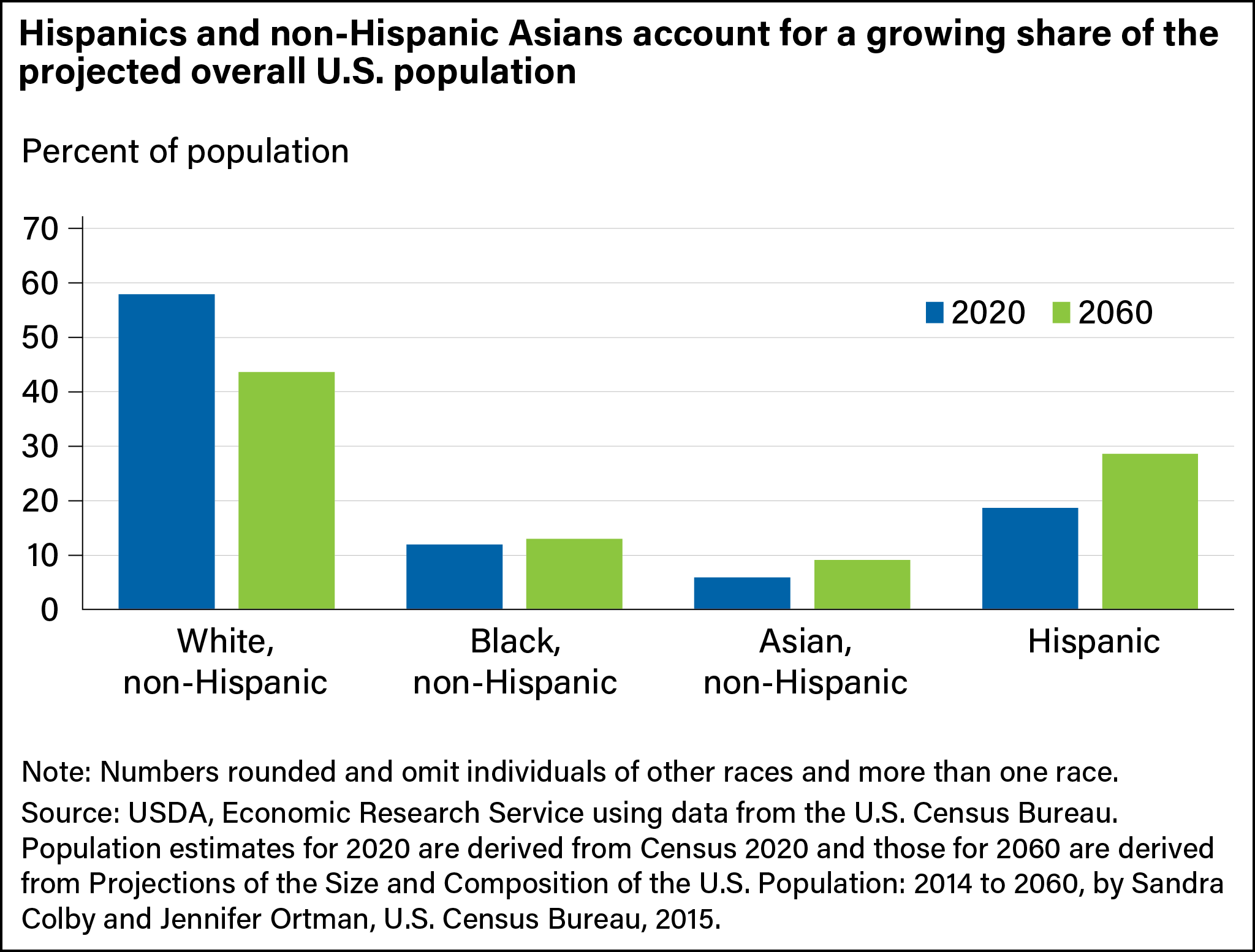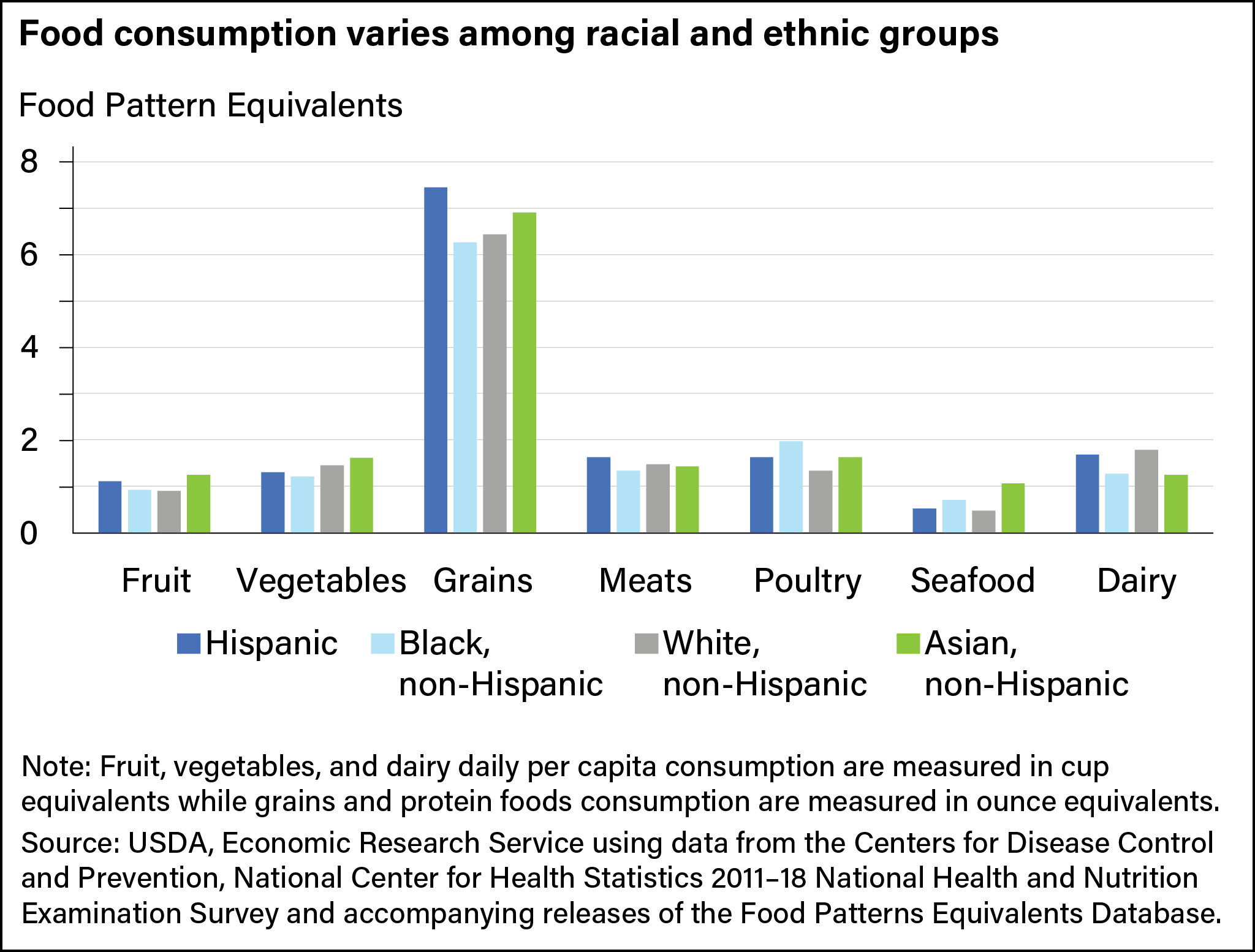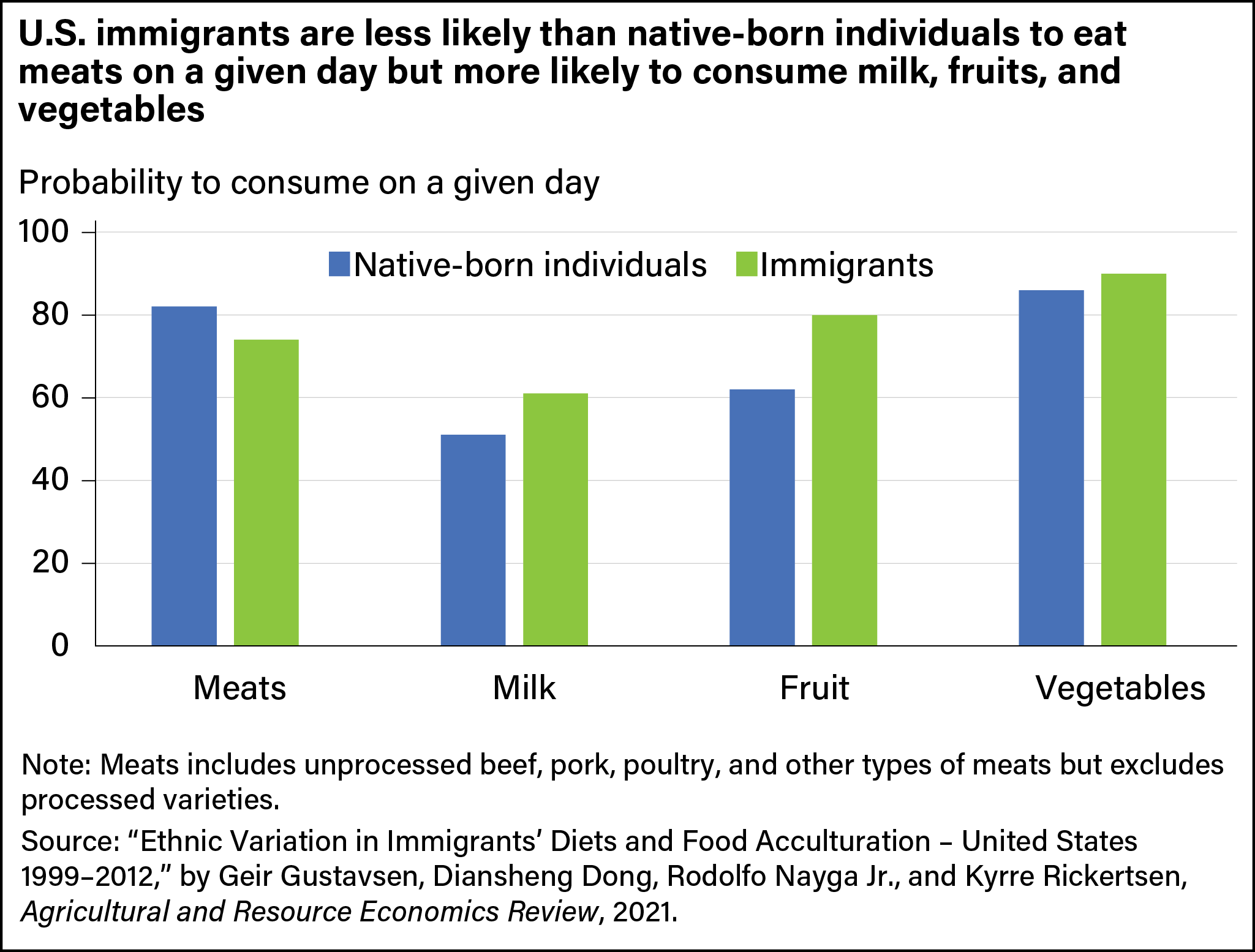
Racial and Ethnic Diversification Will Likely Shape U.S. Food Demand and Diet Quality
- by Diansheng Dong and Hayden Stewart
- 4/4/2022
Highlights
- U.S. demographic trends, including increased diversity brought about by immigration, may cause overall consumer demand for some types of foods to grow faster than demand for others.
- U.S. immigrants generally acculturate in their food choices, adopting eating patterns more like native-born people of their same ethnic and racial group.
- Non-Hispanic Asians may have slightly higher quality diets, on average, than other racial and ethnic groups.
The number of people who call the United States home continues to grow. Results from the most recent decennial census show that the U.S. population increased from about 309 million people in 2010 to about 331 million in 2020. Projections released by the U.S. Census Bureau put the United States on track to reach more than 400 million inhabitants by 2060. Foreign-born residents are forecast to account for about 17 percent of the total U.S. population in 2060, up from 14 percent in 2020. Native-born residents, including children of immigrants, are expected to account for 83 percent.
According to projections, as immigrants arrive from Asia and Latin America, the United States will grow more racially and ethnically diverse. Between 2020 and 2060, the Census Bureau predicts that individuals of Hispanic origin will grow from 19 percent to 29 percent of the total population. Non-Hispanic Blacks are forecast to rise from 12 percent to 13 percent. Non-Hispanic Asians are predicted to increase from 6 percent to 9 percent. And non-Hispanic Whites are predicted to decrease from 57 percent to 44 percent of the total population.
These changes in population will likely reshape the types of foods people eat in the United States and how foods are consumed. Many factors, such as income, prices, age, household size, and nutrition knowledge, shape a household’s food needs and choices. Along with these factors, race and ethnicity often play a role in food choices and may be associated with deep-rooted food customs.
The USDA, Economic Research Service (ERS) has been examining how trends in the U.S. population might reshape food consumption and diet quality since the early 2000s.
U.S. Food Demand Varies Across Racial and Ethnic Groups
As the population diversifies, the demand for some agricultural commodities also changes. Data from the National Health and Nutrition Examination Survey (NHANES) are widely used to study U.S. food consumption patterns and trends. A USDA-supported survey component, called What We Eat in America, asks individuals to report all foods and beverages consumed over 2 nonconsecutive days.
Food consumption records provided by 2011–18 NHANES participants confirm that individuals identifying with different racial and ethnic groups vary in their food choices. On a per-person, per-day basis, non-Hispanic Asians consumed the most fruits (1.24-cup equivalents), vegetables (1.62-cup equivalents), and seafood (1.06-ounce equivalents). Hispanics consumed the most meat (1.62-ounce equivalents). Non-Hispanic Blacks ate the most poultry (1.98-ounce equivalents). Non-Hispanic Whites consumed the most dairy products (1.79-cup equivalents).
While differences in income, household size, and other factors likely drive some of the above relationships, deep-rooted food customs also appear to be a factor in these patterns. Similar to current NHANES data, a 2003 ERS study confirmed that non-Hispanic Asians consume more seafood than other racial and ethnic groups after controlling for other factors. The same study also correctly predicted that as the Asian-American population grew, the U.S. seafood demand would grow faster in the 2000s and 2010s than the demand for meat and poultry.
A 2021 ERS study used food consumption records provided by 2003–18 NHANES participants for a long-run perspective on how U.S. fluid cow’s milk consumption has been changing over time. Among other findings, the researchers confirmed that non-Hispanic Whites drink more fluid cow’s milk than other racial and ethnic groups controlling for age, gender, education, and other potentially complicating factors. The study also identified that non-Hispanic Whites account for a shrinking share of the overall population, which is a contributing factor in declining U.S. per capita milk consumption.
Immigrants Change Their Eating Habits With Time Spent in the United States
Immigrants arriving in the United States bring with them, at least initially, food consumption habits learned in their originating countries. Food consumption patterns vary between native-born individuals and recent immigrants. Using NHANES dietary intake records, an ERS researcher and a visiting scholar to ERS recently found that, on any given day, new immigrants are less likely to eat meat than native-born individuals in the same racial and ethnic group (75 percent versus 81 percent) but more likely to drink fluid cow’s milk (56 percent of immigrants versus 51 percent of native-individuals), more likely to eat fruit (74 percent versus 62 percent), and more likely to consume vegetables (88 percent versus 86 percent).
The ERS researcher and visiting scholar also found that, as time goes on, immigrants acculturate in their food choices and adopt eating patterns more like native-born people of their same ethnic and racial group. In other words, differences in food demand between immigrants and native-born U.S. citizens of the same racial and ethnic background do not persist over time, unlike those between Hispanics, non-Hispanic Whites, non-Hispanic Blacks, and non-Hispanic Asians.
Food acculturation typically happens within 5 to 10 years of one’s arrival in the United States. This tendency is most pronounced among non-Hispanic Asian immigrants. The probability that a non-Hispanic Asian immigrant consumes meat on a given day increases by 16 percent within 5 years of the individual’s arrival in the United States and by 22 percent within 10 years.
The likelihood an immigrant consumes fruit on a given day conversely tends to fall with time spent in the United States. The probability that a non-Hispanic Black immigrant eats fruit on a given day falls by almost 8 percent in 5 years and almost 12 percent within 10 years.
Differences in Diet Quality Also Exist Among Racial and Ethnic Groups
Differences in what people eat are associated with differences in their diet quality. The Healthy Eating Index (HEI) is a tool for measuring diet quality. Specifically, it can be used to assess the degree to which a set of foods aligns with recommendations in the Dietary Guidelines for Americans. The HEI is updated every 5 years in concert with each new version of the Guidelines by USDA’s Food and Nutrition Service (FNS). According to FNS, among participants in the 2015–16 NHANES, the average HEI score was 59 out of a possible 100 points which indicates that individuals do not in general conform to dietary recommendations. Among racial and ethnic groups, non-Hispanic Asians scored highest (65 points out of a possible 100 points). Numerous studies confirm that healthier diets, measured by higher HEI scores, are associated with improved health and reduced risk of disease.
ERS researchers have used the HEI to measure the dietary quality of foods purchased and consumed by U.S. households and individuals. A 2019 ERS study used food consumption records provided by NHANES participants from 2003 through 2016. A statistical model was estimated to identify the effects of income, age, gender, ethnicity, education, and prior history of military service, among other factors, on individuals’ diet quality. While the study was focused primarily on effects of military service, ERS researchers also identified ethnicity effects. Overall, Hispanics, all else constant, were found to have HEI scores about 2.4 points higher than other individuals. The study did not consider Asians because NHANES data collected before the 2011–12 survey cycle did not identify individuals belonging to that racial group.
As the U.S. population further diversifies with a growing share of Asian, non-Hispanic and Hispanic people, domestic demand for agricultural products and overall diet quality in the Nation will likely also continue to shift. Even as new immigrants acculturate and adopt the eating patterns of native-born U.S. citizens of their same racial ethnic background, food demand and diet quality differences remain among racial and ethnic groups. Food consumption patterns and diet quality measures broken down by racial and ethnic groups continue to be informative for policymakers and other decision-makers.
This article is drawn from:
- Lin, B., Variyam, J., Allshouse, J.E. & Cromartie, J. (2003). Food and Agricultural Commodity Consumption in the United States: Looking Ahead to 2020. U.S. Department of Agriculture, Economic Research Service. AER-820.
- Stewart, H., Kuchler, F., Dong, D. & Cessna, J. (2021). Examining the Decline in U.S. Per Capita Consumption of Fluid Cow’s Milk, 2003–18. U.S. Department of Agriculture, Economic Research Service. ERR-300.
- Dong, D., Stewart, H. & Carlson, A. (2019). An Examination of Veterans’ Diet Quality. U.S. Department of Agriculture, Economic Research Service. ERR-271.
- Gustavsen, G., Diansheng, D., Nayga, R., Jr. & Rickertsen, K. (2021). "Ethnic Variation in Immigrants’ Diets and Food Acculturation – United States 1999–2012". Agricultural and Resource Economics Review. 50(1), 43-62. doi:10.1017/age.2020.17.





